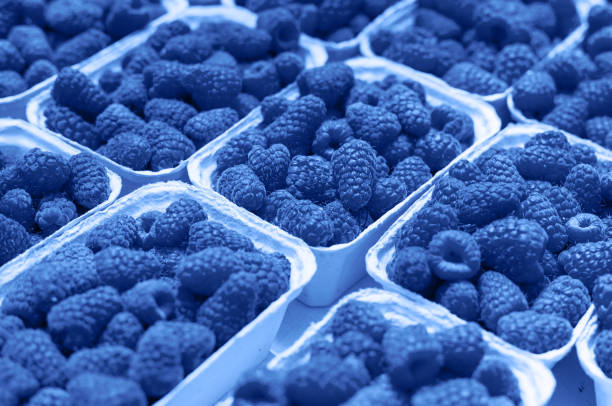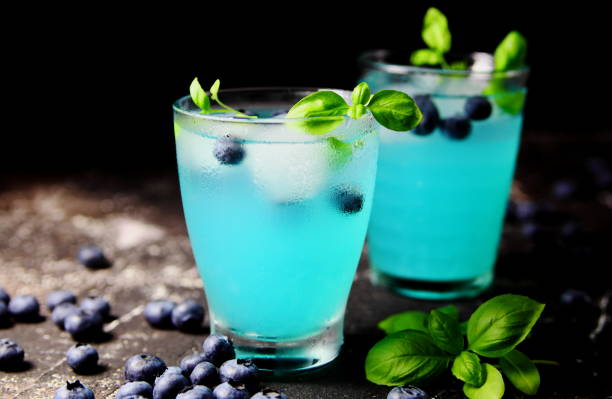Is Blue Raspberry Real? Everything You Need to Know
During the summer, which is essentially the raspberry season, you might find yourself in your backyard one day when blue-tongued little kids run after each other around the pool. Do not fret; they’ve munched on ice pops with blue raspberries.
Blue raspberries have caused strange blue tongue streaks from childhood, and the blue raspberry flavor certainly won the hearts of kids and confectionery companies alike. No amount of shelf space or packaging can conceal its attention-grabbing and sometimes perplexing color.
You can find it in everything from cotton candy to flavored vodka to sports drinks and fruit snacks. However, I sincerely hope you are planning to wait to harvest any of them on the farm because they are manufactured in the laboratory.

What is Blue Raspberry?
Blue raspberry is a synthetic coloring and flavoring used in soft drinks, syrups, candies, and snack foods. Its flavor and color were first employed in the US in 1958 to make snow cones more interesting.
Concerned with customer safety, regulatory bodies like the US Food and Drug Administration offer producers rules on artificial flavors and colors. Since 1969 they have allowed the use of blue raspberry as a nutritional component.
History of Blue Raspberry Flavor
Everything began with the ICEE — slushy frozen treats that were accidentally created in the 1950s (like many of our favorite meals) and only came in cherry flavor. Some marketing genius decided to create one in blue in 1970.
They decided to use a raspberry flavor with blue color instead of blueberry. Compared to the cherry ICEE, which was unmistakably red, this created a wonderful and even patriotic contrast.
Like flavor ice and otter pops, ice pops gained popularity in the 1960s and 1970s. It was challenging to tell the four red tastes apart because they were all red (strawberry, cherry, watermelon, and raspberry).
Raspberry was changed to blue raspberry to simplify things, while other colors, such as cherry and watermelon, were made darker or lighter. The idea of the blue raspberry is intended to pique your interest and spark your imagination.
It is now commonplace, especially in the sweet sector, where it is added to Slurpees, ice cream, sweets, and gummy bears. Given their popularity, why aren’t their deep red bananas or purple pineapples?
The Advent of Food Coloring
When food coloring first appeared in the 1950s, it was a booming industry. It intensified the colors of artificial components, making them more appealing to young eyes in particular. It settled at amusement park concession stalls, carnival snack kiosks, and ice cream trucks, among other eating establishments.
The flavor lies exactly between the two categories. Citrus flavors are harsh and tart, while scarlet and purple flavors are sweet, nuanced, and deep. Honestly, blue raspberries have everything. Second, it should almost go without saying that blue raspberries are blue.
They include a lot of vital micronutrients like manganese and vitamins C and K, are low in calories, rich in fiber, and have a lot of fiber. These tasty berries are also rich in anthocyanins, strong antioxidants that protect your cells from damage caused by unstable chemicals known as free radicals.
What Flavor is Blue Raspberry?
Blue raspberry is a difficult flavor to describe. If called upon to describe it, the first thing that springs to mind is that it is an eye-catching color similar to windshield washer fluid but tastier and not one that you can find in nature.
The primary flavor component in raspberry sweets and confections, whether blue or not, is sugar, so aside from the blue dye on your tongue, a blue raspberry ICEE doesn’t taste any different from the cherry in terms of flavor from cherries.
However, when it comes to flavor, blue raspberry doesn’t taste like raspberries or even raspberry flavoring. What exactly is the flavor supposed to be, then? Unexpectedly, there is a real fruit that the raspberry flavor is intended to resemble: the white bark raspberry.
Where Does Blue Raspberry Flavoring Come From?
Even though blue isn’t a hue that is frequently seen in foods, many will say that the unique flavor was made out of aesthetic desire. However, the flavor has real-world roots. A fruit exists behind the vivid blue hue; it’s not quite a raspberry.
The berry hiding the blue has a texture and starter flavor similar to a blackberry. The flavor has natural origins, and the Rubus Leucodermis, or whitebark raspberry, is the source of the flavor that we all know and adore.
This raspberry variety exhibits a dark purple color that may have inspired the term “blue raspberry.” However, it is less vivid blue than candy producers think. The plant can be found throughout North America west of the Rockies, from Alaska to Mexico. But it’s an uncommon species.
Where Does Blue Raspberry Color Come From?
When ripe, the plant’s real fruit turns a deep blue-purple color from its initial reddish-purple hue. Raspberries with white bark are not blue. Thus, food scientists created the color and flavor combination of blue raspberry.
It has the astonishing ability to color mouths all over America. The white-barked raspberry was the fruit, coupled with the vibrant blue food dyes we adore.
Frequently, bright blue artificial food coloring, such as dazzling blue, is used to tint food products with the flavoring. The color blue distinguished foods with raspberry flavors from those with cherry, watermelon, and strawberry flavors, which are all red.
The gamble must have worked since the flavor is now an autonomous taste in everything from Jolly Ranchers to the Slurpee machine. The popularity of this surprising color decision may also have to do with color psychology and its significance as a flavor differentiator.
Melvin De Groote was a pioneer in synthetic flavors. He explored the relationship between color and flavor as early as the 1920s. In his research, he noticed that bright, vibrant colors are particularly enticing to kids. The same reasoning applies here. Pink lemonade, for instance, typically sells better and draws kids much more than its traditional cousin, yellow.
Conclusion
Regardless of your opinions on this flavor, blue raspberry is unquestionably enjoyable. Since its first significant breakthrough in the early 1970s, it has been remarkably consistent and never let up. Although chefs and bartenders might sneer or chuckle at the concept, it has a long history in concessions.
Read More:


